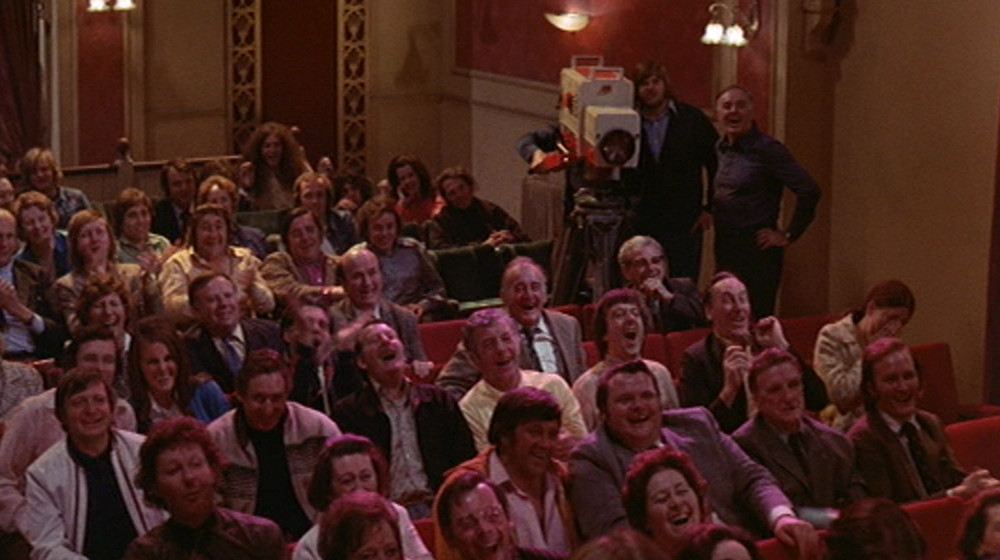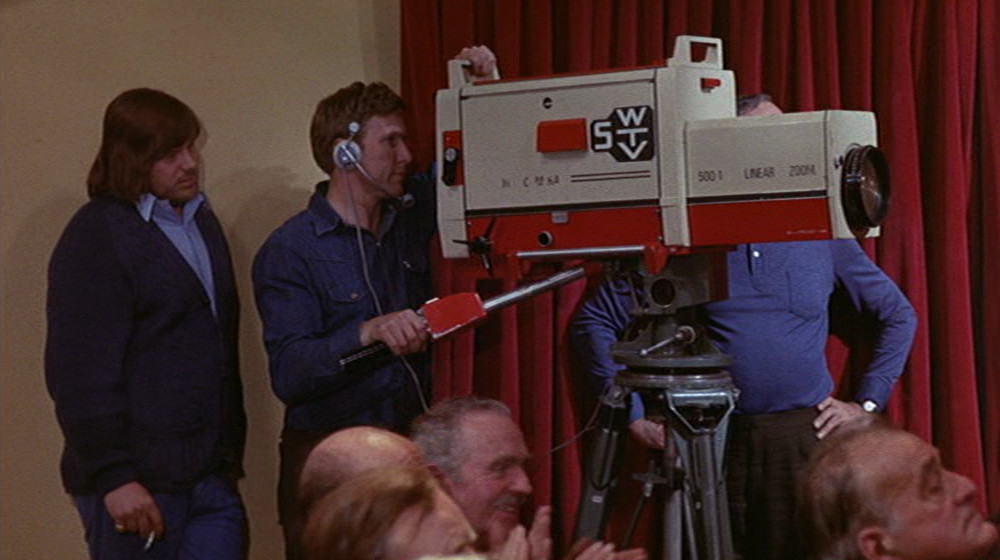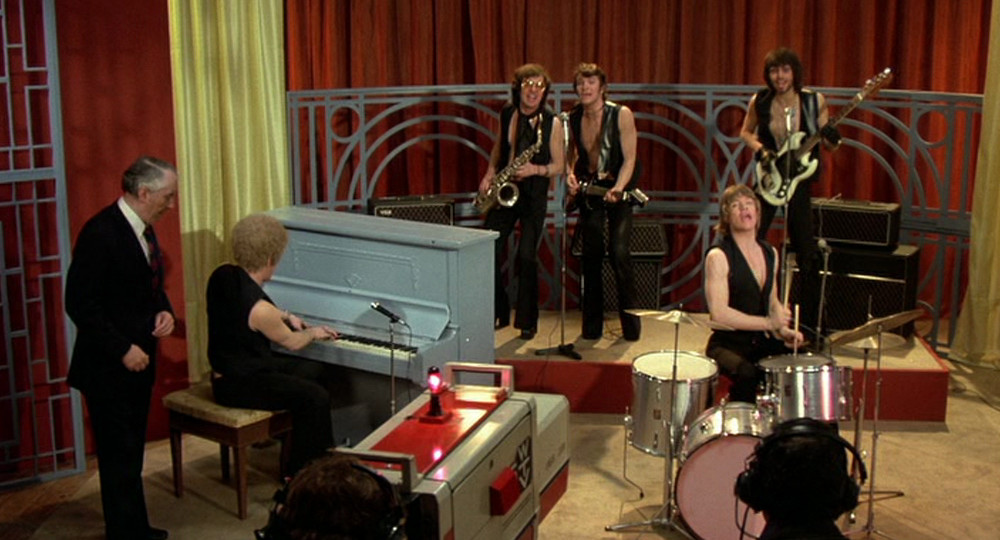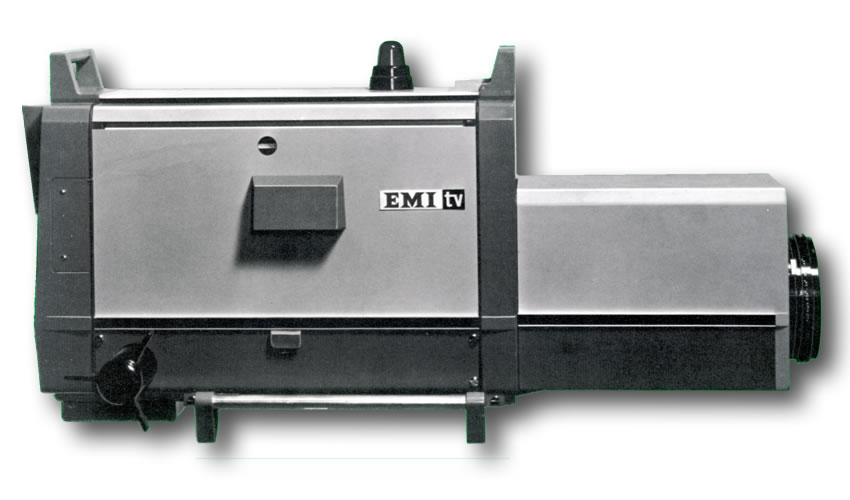What is the single most arousing image during the climax of Carry on Girls, at the beauty contest?

No, not you, Margaret Nolan, put ’em away. We’re far more interested in the following:

That’s a very interesting looking television camera there. If only we could get a better view.

Blimey, I didn’t realise Carry On Girls strayed that far into hardcore pornography.
You will note the large SWTV letters on the side of the camera. This is the only mention of the TV company covering the beauty contest in the film; there’s no reference to them in the dialogue.1 But the name seems clearly chosen in order to avoid bringing to mind any specific ITV franchise. If it had been STV, you might have been tempted to think of Scottish or Southern Television; WTV would have brought to mind Westward. SWTV is safely unlike any existing company in terms of name, while still fitting the idea that they serve an area which contains a seaside resort.
But enough about fantasy ITV franchises. The real question for today is: does this scene in Carry on Girls use a real camera of some description, or is it a custom-made prop?
I have to admit, my gut feeling was that it was a custom prop. For a start, it didn’t quite look like any camera I’d ever seen before. But I was entirely wrong; it really is a real camera. Specifically, an EMI 207, a model which was first released in 1966. And the Museum of the Broadcast Television Camera helpfully contains a picture.2
The EMI 207 was a monochrome camera; in Carry on Girls we never actually see it working, not even a faked image on a monitor somewhere. In fact, if you look carefully at the scene in the film, the pan handle and focus handle are on the same side, which is incorrect. It really was just used purely as a non-functioning prop.
Apparently, there were never many 207s in use – by 1966, TV companies were looking ahead to colour, and didn’t want to invest in further in black and white technology. It seems fairly likely to me that the Carry On gang managed to get hold of it from a studio which had recently converted to colour. Carry on Girls was made in 1973, which is exactly the right point for this.
Ah, but which studio? Sadly, there are no obvious candidates; even finding which studios were equipped with 207s seems to be difficult. This may, paradoxically, actually make the potential source of this camera easier to find at some point, but I have no current ideas.
* * *
It’s not just Carry on Girls that this camera appeared in.
Two years later, in 1975, the second Confessions film was released, Confessions of a Pop Performer. I’ll make no apology for enjoying it, if only for a parody of Hughie Greene presenting a TV show called Star Knockers.3
And what do you think shows up at the television studio, where the band Kipper are performing their latest?

Note the addition of a tally light to the top of the camera since its appearance in Carry on Girls.
The camera actually gets used twice; near the end of the film, David Hamilton does a piece to camera in the foyer of the theatre. It’s clear from this shot that the camera still has the full SWTV livery from Carry on Girls, even though Pop Performer is set in London:

Honestly, first the Confessions films nick the stars of the Carry On films with Robin Askwith, and then they raid their props cupboard. Outrageous.
It does bring to mind some more questions, though. If this camera was available to be hired out as a prop, does it turn up in any other 70s British films? If so, which ones? And is there a chance that it showed up in an earlier film than Carry on Girls, possibly without the SWTV lettering and paint job? And finally… is there a chance that this camera might still exist, lost in a prop house somewhere?
If you’ve spotted this camera being wheeled through the ruins of the British film industry at any point, do me a favour and let us all know.
Many thanks to the following people for help with this post. As well as them all working for decades in the broadcast industry, they all run some extremely interesting and useful websites, so I thought I’d give them a little more presence at the end of this piece than I normally do.
- Dicky Howett of Golden Age TV, a company who provide vintage TV cameras and other broadcast equipment to productions. The vintage cameras used in the Inside No 9 episode “The Devil of Christmas”? That was them.
- Martin Kempton, who runs the brilliant TV Studio History website. Anything you need to know about any television studio past or present in the UK, you can probably find it there. I’ve use it extensively for pieces like this.
- Brian Summers, who runs The Museum of the Broadcast Television Camera, detailing the history, technology and development of… well, have a guess. See also its sister site, the Broadcast Television Technology Trust.
Finally, thanks to Tanya Jones, who was the person who noticed the camera appeared in both Carry on Girls and Confessions of a Pop Performer in the first place. This is why we live together.
We only get a mention of the “fellow from the television studios”, which is slightly awkward. ↩
Along with this contemporary brochure. ↩
My other favourite gag: referring to an act called The Climax Sisters as “a couple of old pros”. ↩


5 comments
Martin Fenton on 14 September 2024 @ 8pm
The Rank Organisation already had ties with EMI (the Top Rank record label, for example, was taken over by EMI.) It wouldn’t surprise me if Rank had quite a lot of EMI hardware distributed around their many and varied entertainment interests.
George White on 21 September 2024 @ 2am
I am obsessed with fantasy ITV franchises.
ECTV in Only When I Laugh (1982)
TVTen in Giro City (1982).
British Global Press TV in Contact (1996)
United TV in Spearfield’s Daughter (1986)
Northern Television in Our Friends in the North (1996)
Avon TV in Theatre of Blood (1973)
Rainbow TV in Madhouse (1974)
LTN in The Apocalypse Watch (1997)
Peak TV in Trog (1970)
Allied TV in Die, Die, My Darling (1965)
LTV in Omen III – the Final Conflict (1981)
QTV in Journey to the Unknown (1968)
IBTV and Daylight (a TVAM/GMTV proxy) in Prince William (2002)
Midiffusion in Take A Girl Like You (1970)
WIX-TV (a British station serving Wimbledon and its environs despite the name) in Scooby Doo – the Warlock of Wimbledon (1978)
CJS TV in Thriller – Death to Sister Mary (1974)
KTV in The Man who Had Power Over Women (1971)
The new Disney+ series Jilly Cooper adaptation Rivals has ‘Corinium Television’.
Although discovered at least 3 I thought were fantasy franchises
Lion TV in There’s A Girl in My Soup (British Lion’s VT TV arm)
Discovered Ewart TV (who I noticed in Scandalous (1984)) and Granville TV in The Deadly Bees (1966) were real companies. Both made music videos, handled COI film work, and Ewart later was used for BBC’s Wizbit and a lot for C4 including Vic Reeves’ Big Night Out, and later merged with Capital Radio.
And then there’s BBC manques
The BRC in Young Indiana Jones (1995)
BRT (British Radio-Television) in Stockholm (2018)
GBTV in Who is Killing the Great Chefs of Europe (1979)
The British Television Service in the Journey (1959)
The English Broadcasting Service/English Television Network in Mission; Impossible (1960s)
UKBC in Morons from Outer Space (1985)
BTV in various (The Third Secret (1964), Community (2012), Bash Street Kids)
EBC (not that one) in The Guardians (1971)
The Itch (1965 Paramount cartoon possibly later shown like many Modern Madcaps on ITV after TVAM) features BBC ‘Home Service Television’ which shows a tuxedoed, moustachioed newsreader and westerns as cultural exchange programs.
Oliver Wake on 25 September 2024 @ 11am
In reply to George White… Another ersatz BBC for you: In the superb 1962 TV play Heart to Heart about a television personality, Television Centre features heavily but with all signage, cameras etc rebranded to BTV. Highly recommended viewing for anyone wanting to see inside various studios, control rooms etc in the freshly minted TV Centre.
Paul Martin on 1 October 2024 @ 3pm
Not forgetting OHBC (Outer Hebrides Broadcasting Corporation) in BBC Scotland’s Naked Video.
Rob on 24 March 2025 @ 3am
If you like old tv cameras and studio shots, Quatermass (1979) has a pile of scenes shot in the last remaining UK TV station, “BTV” .. About halfway through episode 3 is worth a look. (is on YouTube..)
Comments on this post are now closed.